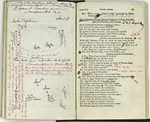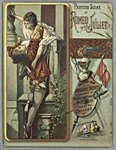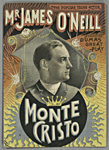Shakespeare and European Heroics
"I told you in my last [letter] that the theatre here was roofless and otherwise unfit for use. It was little better Tuesday night.… At ten o'clock, a half-scene and a red sheet were drawn aside and the play (Othello) began, to about seventy-five people in hats, overcoats and heavy fur wraps.… Next day, we tried Caesar for a matinee.… " — Edwin Booth, writing to his daughter Edwina from Kansas City, October 27, 1887
Plays of Shakespeare began traveling in the United States in the
18th century; by the end of the Civil War, productions
of them were on almost continuous transcontinental tours. The
tragedies were the most popular, with Edwin Forrest's
Othello and Edwin Booth's Hamlet offering validation
of America's right to claim a place in English-language theater.
Shakespeare was also performed in French (in New York and New
Orleans theaters) and on the bilingual tours of Italian stars
Adelaide Ristori and Tommaso Salvini.
The search for heroic, dramatic roles also led performers to
European history plays and novels, which were readily available in
the United States in English or their original languages. The
historical dramas of Victorien Sardou were popular with European
and American actresses, who found success portraying the
sacrifices of Cleopatra and Floria Tosca. Older actresses, such as
Clara Fisher Maeder and Louisa Lane Drew, were drawn to The
School for Scandal and other English comedies of manners.
Male actors found a wealth of juicy roles in the plays of Edward
Bulwer Lytton, including Richelieu (1839) as well as a
number of modern-dress melodramas. Most American actors learned
fencing and theatrical swordplay for Shakespearean roles and were
delighted at the opportunity to show off their prowess in the many
adaptations (often plagiarized) of the historical novels of
Alexandre Dumas père. His The Corsican Brothers,
which required its star to play twins, was especially popular with
many athletic actors. Rival companies of The Three Musketeers,
The Count of Monte Cristo, The Queen's Necklace, and
The Man in the Iron Mask were also popular across the country.
Refer to Map of the United
States and Mexico (1859), which
details explorers' trails, transportation routes,
settlement patterns, and locations of mineral wealth.
These factors greatly affected tours undertaken by
performing artists in America during the first half of
the 19th century.


